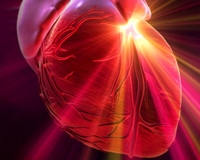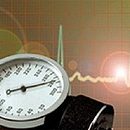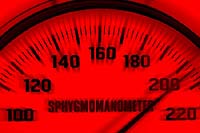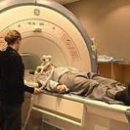Exudative pericarditis - ailment serious. However, with timely appeal to the doctor, this disease is successfully treated. This article covers issues related to the identification and treatment of exudative pericarditis.
Content
 Pericardium or Cardiac Bag - This is the outer sheath of the heart. It consists of two sheets. The outer sheet is more denser, consisting of connective tissue, internal - from one layer of cells.
Pericardium or Cardiac Bag - This is the outer sheath of the heart. It consists of two sheets. The outer sheet is more denser, consisting of connective tissue, internal - from one layer of cells.
Pericardi performs important functions for proper work of the heart:
- Pericard fixes the heart in the chest and keeps the heart in a normal position.
- It serves as a barrier to penetrate infection from the chest in the heart.
- Pericarde prevents excessive heart expansion.
- Pericarde helps to maintain the desired pressure in the heart chambers.
Exudative or empty pericarditis is an inflammatory disease of the cardiac bag (pericardium), which is accompanied by an increase in the amount of fluid (traffic) in the cavity of the heartbag. If in a healthy body between the pericardic sheets in the heart bag is from 20 to 0 milliliters of the liquid, then with an exudative pericardia, the volume of the liquid can reach 300 milliliters.
Most often, the cause of exudative pericarditis is various infectious diseases - staphylococcal or streptococcal infections, tuberculosis. Many rheumatic diseases are accompanied by the accumulation of fluid in the pericardia. In some cases, the exudative pericarditis occurs after operations on the heart, with traumatic damage to the heart and heart handbag, during the injuries of the chest, sometimes with extensive myocardial infarction.
The liquid between the cardiac bags can accumulate quickly, but sometimes accumulation is slow. Accumulating in the pericarda liquid leads to squeezing. Complete first of all camera hearts (cavities atrial and ventricles). It makes it difficult to fill the atria and ventricular blood and blood release from ventricles decreases.
The greater the amount of accumulating fluid, the more the heart is squeezed. Severe circulatory disorders arise, which can lead to the death of the patient. If the fluid in the pericardia accumulates slowly, the patient's condition remains satisfactory for a long time. In the initial stage of the disease appear blunt pain in the field of heart. Then there is a shortness of breath, rapid heartbeat. Sometimes all this may be accompanied by chills and high body temperature.
Over time, signs of heart failure are joined. In the patient, there is cyanosis (silance) of lips, wings of the nose, ear-sinks, swelling of the cervical veins, swelling on the legs. Pulse is usually frequent. Blood pressure is low due to reduced cardiac output. Often enhanced liver.
When listening to the tone of the heart deaf. The radiograph determines the expansion of the heart boundaries in all directions. On the electrocardiogram decreased by all keys of cardiac complexes. With echocardiographic examination, liquid is found between the pericardic sheets. This method allows you to determine the presence of fluid in the heartbag, starting with 50 milliliters.
Treatment of patients with exudative pericarditis is carried out under hospital. The patient must comply with bed. In the presence of fluid in the heartbag, but the absence of signs of heart challenge, drug treatment is carried out - antibiotics, hormones, nonsteroidal anti-inflammatory drugs, antihistamines, diuretic.
If the amount of fluid in the pericardial cavity increases over 200-300 milliliters, or the patient from the very beginning shows signs of heart compression, perform pericardial puncture according to the method of Larreya. In the left corner between the swords and seventh rib cartilage, the needle is introduced to a depth of 2-3 cm, at the same time introducing a novocaine solution, pierce the outer leaflet of the pericardium and remove all the liquid from the heartbag. If the resulting fluid is purulent, the bag cavity is washed with an antiseptic solution and impose antibiotics or put drainage for the subsequent washing of the pericardial cavity and fluid outflow.
Sometimes the accumulation of fluid in the heart bag lasts more than 6 months. Then such an exudative pericarditis is considered chronic. Often, viral infections, tuberculosis, accumulation of urea exchange products for kidney diseases lead viral infections.
Manifestations of chronic exudative pericarditis depend on the degree of heart grave. If the degree of heart compression is small, chronic pericarditis can flow without complaints and sometimes it is randomly detected by X-ray study of the lungs. Only a small part of the patients appear complaints about unpleasant sensations in the field of heart.
With a large number of liquid in the cavity of the heartbag, if the outer leaflet of the pericardia is well stretched out of the signs of the heart of the heart, but may be squeezed with esophagus, trachea, bronchi, return nerve. Then there are complaints about violation of swallowing, cough, witness voices and in these cases, even with a very large number of liquid in the heart handbag, there are no complaints from the heart.
Echocardiographical research helps to clarify the diagnosis. Sometimes a computer or magnetic resonance imaging.
In case of chronic exudative pericardia, the pericardial cavity punctured. The resulting liquid is investigated to clarify the nature of the process. Usually a patient with chronic pericarditis operate. Produce thoracotomy (dissection) of the chest and remove pericardium, leaving only its sections where the nerve passes. Mortality in these operations is minimal, almost all patients are recovered.









